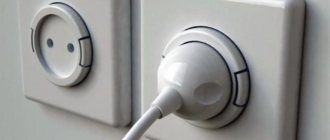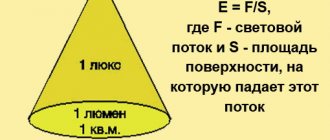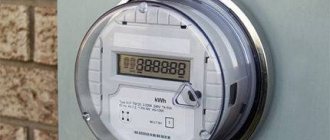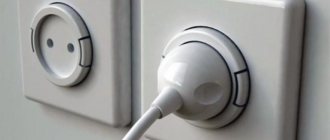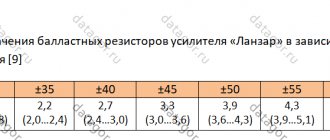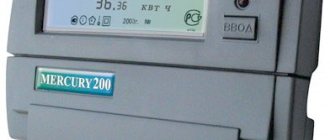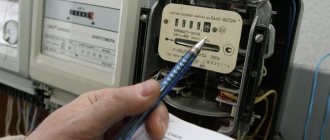To select the cross-section of power cables and wires when laying electrical networks for consumers, you need to know what power devices will be included in them. You can learn how to calculate the power consumption of an electrical appliance by understanding the very concept of power. For this, information from the school curriculum and basic concepts about current, voltage, and resistance will be enough. In addition, this knowledge is needed when purchasing household electrical appliances.
Electric current power
Total power and its components
Electrical power is a quantity responsible for the rate of change or transmission of electricity. The total power is denoted by the letter S and is found as the product of the effective values of current and voltage. Its unit of measurement is volt-ampere (VA; V A).
Total power can consist of two components: active (P) and reactive (Q).
Active power is measured in watts (W; W), reactive power is measured in vars (Var).
It depends on what type of load is included in the electricity consumption circuit.
Active load
This type of load is an element that resists electric current. As a result, the current does the work of heating the load, and the electricity is converted into heat. If a resistor of any resistance is connected in series to a battery, then the current passing through the closed circuit will heat it until the battery is discharged.
Attention! An example of a thermal electric heater (TEH) can be given as an active load in AC networks. The heat generated on it is the result of the work of electricity.
Similar consumers also include spirals of light bulbs, electric stoves, ovens, irons, and boilers.
Capacitive load
Such loads are devices that can accumulate energy in electric fields and create movement (oscillation) of power from source to load and back. Capacitors, cable lines (capacitance between conductors), capacitors and inductors connected in series and parallel in a circuit serve as capacitive loads. Sound power amplifiers and synchronous electric motors in overexcited mode also load the lines with a capacitive component.
Inductive load
When the consumer of electricity is certain equipment, which includes:
- transformers;
- three-phase asynchronous motors, pumps.
On the plates attached to the equipment you can see such a characteristic as cos ϕ. This is the phase shift coefficient between current and voltage in the alternating current network into which the equipment will be connected. It is also called the power factor; the closer cos ϕ to unity, the better.
Important! When a device contains inductive or capacitive components: transformers, chokes, windings, capacitors, the sinusoidal current lags in phase with the voltage by a certain angle. Ideally, the capacitance provides a phase shift of -900, and the inductance provides a phase shift of +900.
Cos ϕ values depending on the type of load
The capacitive and inductive components together form reactive power. Then the total power formula looks like:
S = √ (P2 + Q2),
Where:
- S – apparent power (VA);
- P – active part (W);
- Q – reactive part (Var).
If we display this graphically, then we can see that the vector addition of P and Q will be the total value of S - the hypotenuse of the power triangle.
Graphic explanation of the meaning of total power
Calculation of main electricity consumers
Every home uses a variety of household appliances - from electronic watches to dishwashers. They all consume electricity, and you need to be able to calculate the values for power from a single-phase or three-phase network. The total amount will depend on the standard and tariff established in the country.
Washing machine
This device belongs to powerful household appliances. Average power is 2000 W. At one time the machine works for about one and a half hours. Accordingly, 2000 × 1.5 = 3000 W of energy or 3 kW will be consumed per wash. This number is multiplied by the number of washes. For example, a person does 10 washes in a month - the machine will use 3*10=30 kW of electricity. When multiplied by the tariff, the cost that the owner must pay to the service provider is obtained.
Energy consumption will also be calculated depending on the weight of the laundry and the selected mode. The operating time of the device also depends on these indicators. A significant part of the energy is spent on heating water.
Computer and laptop
A desktop computer consists of a power supply and a monitor. Each consumes its own amount of electricity, so the power required for operation will be equal to their sum. On average, a power supply requires 350-550 W. The load also depends on the programs being executed. In the case of correspondence on social networks, energy consumption will be minimal, and when working in complex graphics programs, it will be maximum. The monitor requires about 80 watts of power to operate, depending on its size. Therefore, the average power will be approximately 0.5 kWh.
The laptop consumes less energy since only the power supply is used. Average energy consumption will be 0.05-0.1 kW*
TV
As with a computer monitor, the power consumption of a TV depends on the size of the screen. The design of the device also has an impact. Old TVs powered by a cathode ray tube require 60-100 W, LCD models about 150-250 W, plasma models - 300-400 W.
Standby mode also requires energy. This is because there will be a red light on the screen, which also requires power. For devices based on a cathode ray tube, 2-3 W are required, for modern TVs 4-6 W.
Fridge
This is a device that works without interruption 24 hours a day, seven days a week. But depending on the time of year, the amount of electricity needed will vary. In winter, operation requires approximately 2 times less electricity than in summer.
Refrigerators are divided into classes based on energy consumption. Products with low energy consumption consume energy approximately equal to the volume of the device in liters. A device with a volume of 250 liters requires an average of 250 kW per year. The exact value can be found in the documentation for the refrigerator.
Kettle, iron, stove
An electric kettle requires on average 1.5-2.5 kWh of energy. The water heats up in about 4 minutes, i.e. this energy will be spent in 15 times. An iron consumes approximately the same power, but it depends on the operating mode. Maximum load required for initial heating. An electric stove is a powerful device; it requires approximately 3 kWh of energy to operate.
Microwave
The amount of electricity consumed depends on the volume, equipment, and operating modes. For quick heating, 0.9 kWh is required, for defrosting 0.2-0.4 kWh. The volume of food also affects power - a larger portion will require a greater load.
Warm floor
Electricity consumption for heated floors depends on the type and quality of thermal insulation, operating mode, room size, climatic conditions, type of coating and other important criteria. If the floor is the only and main source of heating, then about 0.2 kWh of energy will be spent per 1 square meter. To maintain a comfortable temperature in the room, 0.1-0.16 kWh of electricity will be consumed per 1 sq.m. To calculate the monthly costs for heated floors, you should multiply the consumption by 1 sq.m. on the area of the room, operating hours and number of days per month. For a more accurate determination, you can use a wattmeter. It is connected to an outlet and to an electrical receiver.
Negative effects of reactive load
Learn to easily calculate the power consumption of an electrical appliance
The reactive load does not perform any useful work. Fluctuations in the reactive component from source to consumer only cause parasitic losses. In addition, industrial enterprises are required to pay for the reactive energy supplied to them. This is due to the fact that most energy receivers are electric motors and transformers. The amount of electricity consumed (kWh) does not all go to useful work, but you also need to pay for its reactive component.
Capacitor compensation units will help solve this problem. After all, if you connect a capacitive load in parallel with an inductive load, you can reduce the effect of parasitic currents to a minimum. Such installations are installed at substations supplying consumers.
How to correctly convert these units
A watt is equal to a kilogram per square meter divided by cubic seconds. The prefix kilo means multiply by 1000. The same principle applies to power indicators, that is, 1 kW equals 1000 watts and 1000 volts. This means that 1 unit = 0.001 subunits. That is, if you make a power transfer, a 3 kW electrical appliance will be equal to 3000 W.
You will be wondering what power the 16a machine is designed for
Conversion formula
In electricity
To simplify measurements in electricity, a subblock is used. You can find out how many watts are in kilowatts and convert the units by multiplying watts by 103 and dividing by 1000. To do the reverse conversion, you need to multiply kilowatts by 103 or multiply the known values by 1000.
Amount in electricity
In heating
Joules must be used to measure thermal power. This is the work done by 1 newton per 1 meter. To convert joules to kilowatts, you need to use the joules subunit. 1 kJ contains 0.239 kcal. There are 4.1868 kJ in 1 kcal. 1 kW contains 860 kcal. This means that 1000 kcal is 1163 kW per hour.
Thermal measures
Formula for calculations
How to calculate electrical energy consumption
All data necessary to be substituted into the formula for calculations can either be measured or taken from the characteristics of the instruments used.
For your information. If the passport data indicates the value of cos ϕ, it means that the electricity received by the device will have a reactive component. This also needs to be taken into account when calculating.
The formula for calculation is:
P = I * U * cos ϕ,
Where:
- I – current in amperes;
- U – voltage in volts;
- cos ϕ – phase shift.
In the case of an active load, the phase shift is not substituted into the formula, and it has the form:
P = I * U.
Features of calculation
To calculate power without having complete data on current and voltage consumption, you can use average characteristics. By consulting reference books, you can find out that lighting equipment can consume current up to 15 A. The maximum current of powerful devices reaches 50-60 A. The power factor, if it is not indicated or known, can be taken as 0.7 - this is the average value.
Single-phase voltage in a household network is 220 V. Its linear value in three-phase networks is 380 V.
Mathematical operations
The basic formula allows you to calculate an unknown quantity when the other two are known. For example, if the current consumed by the device is known I = 2 A and the network voltage U = 220 V, then the power consumption is equal to P = 2 * 220 = 440 W.
For example, it is known that the iron consumes 2 kW, and the voltage in the outlet is 220 V, then you can find the current strength for which the cross-section of the power cord is designed.
I = P/U = 2000/220 = 9.1 A.
In the case of fractional values, when using a calculator for calculations, the obtained values are rounded to tenths of the units of the desired value.
Basic formulas for calculation
Rules for calculating power consumption
In everyday life, when the need arises to independently determine the power consumption of electricity, do the following:
- determine the voltage required to power the device;
- find out the rated current from the passport data.
How to find out the power of an electrical appliance if not a single parameter is known? Household electrical appliances are designed for 220 V.
To determine power, it is permissible to measure current consumption. This can be done using an ammeter. It is connected to the circuit in series, having previously set the highest measurement limit - at least a hundred amperes. Current clamp meters will help you easily measure current, for which one of the conductors is grasped by the clamp sensor, and the readings are displayed on the display. Knowing the voltage, multiply it by the measured current to obtain the amount of power consumed.
Clamp meter
How to take meter readings correctly?
- Induction devices are “old-fashioned” bulky devices with a rotating wheel.
- Static - or modern electric.
Many people still have induction ones, but the trend towards switching to electronic models is already clearly visible - they calculate more accurately, look better, and do not make noise.
When taking readings from an induction device, pay attention to the first 5 digits (some models have 4). The last digit is usually placed slightly separately or highlighted in a different color, it rotates relatively quickly - it is, as a rule, not written on the receipt (for an even and simpler counting) - this is the reading after the “decimal point”
The last digit is usually placed slightly separately or highlighted in a different color, it rotates relatively quickly - it is usually not written on the receipt (for an even and simpler counting) - this is the reading after the “decimal point” in the decimal fraction.
It is better to take data on the same day of the month. In some regions of the country, it is customary to call the MES or RES on your own (on the appointed day) and report your readings.
Otherwise, the organization makes calculations based on average consumption over the past months - this data will be reflected in the receipt.
How to take readings from an electronic meter, multi-tariff readings
The electronic device can calculate a single tariff, or can be configured to count for several tariffs (different tariffs are introduced for the purpose of saving - during the day they are a little more expensive than usual, and at night they are much cheaper).
The desired mode is selected in the device menu (modes are usually changed by repeatedly pressing the enter button):
- T1 – for single tariff.
- T2 – for separate payment of the grace period from 23:00 to 7:00 am.
- T3 – one standard tariff and two preferential ones.
When these modes (T1 and T2) are displayed alternately, the device will show different readings that have accumulated over the month at a given tariff.
The difference with previous readings is calculated for each tariff separately.
Calculation of light bulb power
The selection of incandescent lamp power depends on the desired level of illumination of the living space. One 100 W light bulb, working in the dark for at least 12 hours, consumes 1.2 kW of power. For a month this will be 36 kW, for a year - at least 432 kW. If there are 10 light bulbs in an apartment, then the total annual consumption will be 4320 kW. If the price for 1 kW of electricity is 5 rubles, the amount turns out to be decent – 21,000 rubles. Therefore, replacing incandescent lamps with energy-saving light sources: LED lamps, LED strips and the like allows you to save money. In addition, reducing the power of such light bulbs does not reduce the luminous flux. The reduced supply voltage of LED strips also reduces the amount of power consumed.
How to convert watts to kilowatts
Household electrical appliances have different power ratings. It ranges from a few watts to several thousand watts. For convenience of calculation, they lead to a single value. This is usually a kilowatt, denoted kW.
To convert watts to kilowatts, you need to know how many watts are contained in 1 kW. The word “kilo” itself means a thousand. That is, one kilowatt of electricity contains 1000 watts.
For the convenience of converting one unit to another, there are various programs. But converting from one value to another is easy to do on your own.
For example, a house has several electricity consumers, a chandelier with three 60 W lamps, a 150 W TV and a 100 W stereo system. We get 3*60+150+100, the result is 430 W. We know that 1KW contains 1000W. Divide this value by 1000, we get 0.43 kW.
For clarity, we will make several calculations. The resulting conversion from W to kW will be tabulated.
| W | 5 | 90 | 100 | 250 | 500 | 750 | 1000 | 2500 | 10500 |
| kW | 0,005 | 0,09 | 0,1 | 0,25 | 0,5 | 0,75 | 1 | 2,5 | 10,5 |
Often it is necessary to perform the inverse function. Convert from kW to Watts. To do this, the power in kilowatts must be multiplied by 1,000. Let’s make calculations and put them in a table for clarity.
| kW | 5 | 2,5 | 1 | 0,85 | 0,4 | 0,25 | 0,08 | 0,007 |
| W | 5 000 | 2500 | 1000 | 850 | 400 | 250 | 80 | 7 |
Industrial enterprises use electricity consumers with a capacity of several thousand kilowatts. For convenience, the concept of megawatt has been introduced, denoted as mW. The prefix “mega” means 1,000,000. That is, 1 mW contains 1,000,000 W, or 1,000 kW.
Power measurement devices
To measure P, you can use special instruments. A multimeter is suitable for this, to which you can connect a current clamp. How to measure power with a multimeter? The tester is switched on to the alternating voltage measurement mode; the clamps should grasp only one conductor connected to the load.
Measuring with a multimeter
Separating conductors in a cable is not always convenient. In addition, after measurements you need to calculate the power using the formula.
Power meter
To measure, you can use a special device - a wattmeter. The device is plugged into a power outlet, and the load whose power needs to be measured is connected to its output socket. The results of the measurement are displayed on the display in kilowatts.
Power meter
Measuring power with an electric meter
Using a residential electricity meter, you can also check the power consumption of an individual device. To do this you need:
- turn off all energy consumers, leaving only the device under test in consumption mode;
- note the readings at the current moment and record their values in an hour;
- subtract the latest values from previous readings;
- the result will be a measured value.
The main disadvantage of this block of actions is the shutdown of other necessary household appliances.
Information. When using this method, taking a moment, you can see if there is a hidden current leak and the serviceability of the meter. When all devices are turned off, the electric meter should stop.
Methods for calculating average energy consumption
You can calculate the electricity consumption using different methods.
- Taking the annual meter readings and calculating the average monthly consumption based on the obtained value.
- By power, current, voltage of each household appliance.
Calculations can be made using online calculators. The program will perform all the necessary calculations and help develop a system for optimizing electricity waste.
To calculate electricity from the meter, the kW-hours indicated in the previous readings must be subtracted from the current meter value, without taking into account the decimal number.
Energy consumption
Calculating energy consumption for a house or apartment is not particularly difficult. To do this, you need to perform the following algorithm of actions:
- make a table of all electrical appliances used in the house, including lighting lamps;
- put in separate columns: device power, operating hours per day;
- for each energy consumer, calculate (by multiplying the power by the operating time) the average daily consumption;
- sum up all the obtained power values.
Such a calculation will give a real picture of electricity consumption. Using this data, you can control consumption and adjust the daily power consumption of each device.
It does not matter how power consumption is calculated or measured. The main task of the process is to correctly select the cross-section of conductors for wiring, supplying power cables and ensure that automatic protection is triggered. The cable supplying voltage to the room must withstand the simultaneous switching on of all consumers located in it for a long time. Its choice directly depends on the accuracy of determining the power of consumers.
What is the difference between a kilowatt and a kilowatt hour?
Many consumers habitually refer to electricity consumption indicators recorded by an electric meter as kilowatts. But in fact, this indicator is measured in kilowatt-hours (kWh), which is not the same thing at all.
Energy consumption in kWh is determined by the amount of power expended during a certain time.
An example of such a calculation:
- an incandescent lamp of 0.06 kW is used for lighting;
- for 6 hours of operation (approximate operating time during the day), this device will consume electricity 0.06 × 6 = 0.36 kWh;
- per month, the consumption for the specified lamp will be 0.36 × 30 = 10.8 kW*h.
In a similar way, it is easy to calculate the total consumption of electrical energy per month, knowing the duration of switching on of a particular equipment and its power characteristics. Next, you can determine the amount of savings achieved through the use of less energy-consuming equipment and a frugal attitude to resource consumption.
Correct conversion of power units of electrical energy is very important for the consumer. This will ensure safe operation of the equipment and save energy consumption.
Video
Coffee capsule Nescafe Dolce Gusto Cappuccino, 3 packs of 16 capsules
1305 ₽ More details
Coffee capsules Nescafe Dolce Gusto Cappuccino, 8 servings (16 capsules)
435 ₽ More details
Bluetooth adapters

